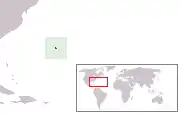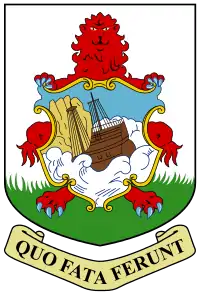Bermudian English
Bermudian English is a regional accent of English found in Bermuda, a British overseas territory in the North Atlantic. Standard English is used in professional settings and in writing, while vernacular Bermudian English is spoken on more casual occasions.[1] The Bermudian accent began to develop following settlement in the early 17th century, and retains traits of Elizabethan English.[2]

| Part of a series on the |
| English language |
|---|
| Topics |
| Advanced topics |
|
| Phonology |
| Dialects |
|
| Teaching |
Higher category: Language |
Casual observers tend to have difficulty in placing the Bermudian accent, as it differs from those that are clearly British, American or Caribbean; they also note that the accent tends to vary between individuals.[3] To Americans, it sounds slightly British, while the British find it more American.
Categorisation
Bermudian English has been called "one of the most severely underresearched varieties of English".[4] It primarily shows a mixture of traits typical of British English and American English, and is generally classified as a form of American (rather than Caribbean) English.[5] The most detailed scholarly study of Bermudian English, in 1933, stated that this type of speech "would create least remark, if indeed any, between, say, Norfolk, Virginia, and Charleston, South Carolina" (Bermuda was settled as an extension of Virginia, and Charleston and the Carolina Province were settled from Bermuda, and Bermuda retained close links with both into the 19th Century, although the start of its tourism industry in the latter 19th Century would see its transport connections move to the North East of the United States, from where most of its visitors continue to come);[6] Bermudian actor Earl Cameron noted that because the Bermudian accent sounded American, he was able to land a speaking role in London's West End in 1942.[7] Large scale West Indian immigration to Bermuda, especially Sandys and Pembroke parishes, began with the expansion of the Royal Naval Dockyard (as a result of the lack of cheap, unskilled labour in Bermuda) at the turn of the twentieth century, and affected the dialect of certain demographic groups. Contemporary printed media record that West Indian agricultural labourers had also immigrated in the closing decades of the Nineteenth Century, when their waning maritime industries forced Bermudians to explore other industries, including agriculture, which was highly stigmatised resulting in a reliance on imported labour, primarily from the Portuguese Atlantic islands. Bermuda's eastern parishes (Devonshire, Smith's, Hamilton, and St. George's) were primarily engaged in ship-building, with most farming (or gardening, as Bermudians term it) taking place in the central and western parishes (Sandys, Southampton, Warwick, and Paget). Consequently, in certain aspects of vocalization, some Bermudian English dialects are close to some versions of Caribbean English,[8] and some would bracket all these varieties to the broad region of the "English-speaking West Indies".[9] Azorean Portuguese has also impacted on Bermudian English as a result of immigration since the 1840s.
Many West Indian workers immigrated to Bermuda during the Twentieth Century, starting with hundreds of labourers brought in for the expansion of the Royal Naval Dockyard at the West End at the start of the century. Many others immigrated later in the century, settling mostly in Pembroke Parish and western Devonshire Parish, north of the City of Hamilton, and the "back of town" (of Hamilton) dialect and the English spoken by many blacks at the West End consequently reflects this. The West End also absorbed large numbers of civilian shipwrights and other workers from Britain who were employed at the dockyard until it was reduced to a base in 1951. The central parishes also absorbed considerable numbers of white immigrants from Britain and elsewhere, especially in the years following the Second World War (when the local government loosened immigration laws to encourage white immigration to counter the black immigration from the West Indies), speaking various varieties of Southern England English, Northern England English, and Scots, et cetera. The central parishes were also where most immigrants from Portuguese territories since the 1840s have settled, and many Bermudians in this area especially speak a Portuguese-influenced Bermudian English as a badge of pride, and most Bermudians without Portuguese ancestry can affect this way of speaking. The East End of Bermuda, which became increasingly cut off from investment and development after the capital moved from St. George's to Hamilton in 1815, has seen the least immigration during the course of the Twentieth Century, with the least effect on the way English is spoken there, though the introduction of motor vehicles in 1948 has led to considerable spread of previously more isolated populations throughout Bermuda. The English of the St. David's Islanders, while often derided, is generally perceived as the most authentic form of Bermudian English.
Characteristics
The accent's most evident characteristic is a variation in letter/sound assignment. The switching of [v] and [w],[10] characteristic of many dialects in Southern England during the 18th and 19th centuries,[11] and of [d] and [dʒ] (similarly to the dialects of English speakers of Gaelic heritage), when combined with a front vowel, can both be seen in the title of a humorous glossary, Bermewjan Vurds (Bermudian Words).[12] The traditional Bermudian pronunciation of the word "boy", used in preference to the term "guy", was originally pronounced in the same way as in Newfoundland: "Bye".[13][14] As in Newfoundland, when the word is used similarly, Bermudians still use this pronunciation, but otherwise generally now say "boy" when speaking of a boy. Bermuda was generally linked administratively to the Maritimes from United States independence in 1783 until about 1870, at which point the formation of the Canadian dominion meant the British Government increasingly grouped Bermuda for convenience with the British West Indian colonies. It is unclear whether any similarities between Bermudian English and Newfoundland English date from this period, or pre-date it. The use of [æ] and [ɛ] is interchangeable and vowels are often elongated. [θ] and [ð] turn into [f] and [v], respectively. Bermudian is also non-rhotic, like British English or New York accent. There's a simplification of codas like 'best' and 'soft" become "bes" and "sof". Coda [ɫ] is semivocalized to [w].
References
- Ruth Thomas, "Notes on Bermudian Language", in "Bermuda connections", Smithsonian Folklife Festival. 2001. Washington, DC: Smithsonian Institution, 2001.
- Petrone, Kelly. Welcome to the Bermuda Department of Tourism's Media Information Kit Archived December 22, 2010, at the Wayback Machine, Corbin & Associates, Ltd
- Weller, Anthony. Celebration Bermuda, The New York Times, June 15, 2003
- Cecilia Cutler, Stephanie Hackert and Chanti Seymour, "Bermuda and Bahamas", in Ulrich Ammon (ed.), Sociolinguistics. An International Handbook. 2nd ed. Vol. 3. Walter de Gruyter, 2006. ISBN 3-11-018418-4. p. 2066.
- Tom McArthur (ed.), Oxford Companion to the English Language. Oxford and New York: Oxford University Press, 1992. ISBN 0-19-214183-X. pp. 116, 352.
- Harry Morgan Ayres, "Bermudian English", American Speech 8:1 (1933), p. 4. Available online to JSTOR subscribers
- Bourne, Stephen (2005). Black in British frame. Continuum International Publishing Group. p. 106. ISBN 978-0-8264-7898-6.
- Cecilia Cutler, "English in the Turks and Caicos Islands: A look at Grand Turk" in Contact Englishes of the Eastern Caribbean, ed. Michael Aceto and Jeffrey P. Williams. John Benjamins: 2003, pp. 51–80. ISBN 90-272-4890-7. p. 60.
- John Wells, Accents of English 3: Beyond the British Isles. Cambridge: Cambridge University Press, 1982. ISBN 0-521-29719-2. p. 561.
- Dependents information on Bermuda, United States. Dept. of the Air Force, 1956, page 3
- On the Opposite Sides of the Continuum: Standard British English and Cockney. A Historical Outline of the Parallel Developments of the Two Varieties, Matteo Santipolo, Università degli Studi di Padova, Department of Linguistic and Literary Studies
- Peter A. Smith and Fred M. Barritt, Bermewjan Vurds - a Dictionary of Conversational Bermudian. Hamilton, Bermuda: Lizard Press, 1988.
- "'BERMEWJAN VURDS' - Our Bermuda Dictionary", by Peter A. Smith and Fred M. Barritt, which lists: "BYE 1) A male child. 2) Plural BYES: WE BYES wrote this book and US BYES and THEM BYES and we sold it to YOU BYES."
- guide to Newfoundland Slang, which records: "B’y - Though originally a short form of ‘boy’ it’s actually gender neutral and isn’t interchangeable with ‘boy’. It adds emphasis to a phrase. Example: Yes, b’y, Go on, b’y."

Countries.png.webp)